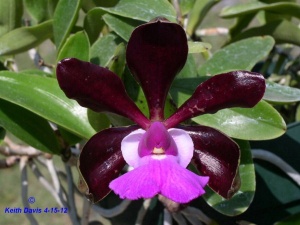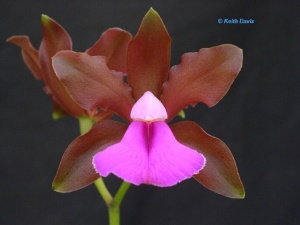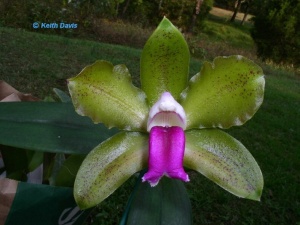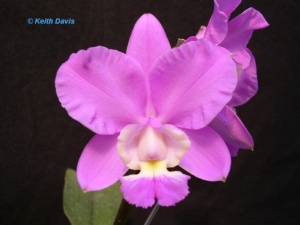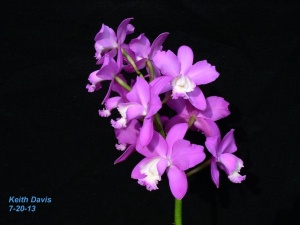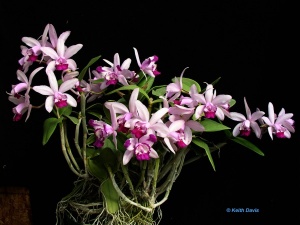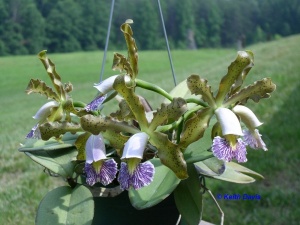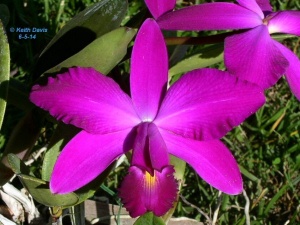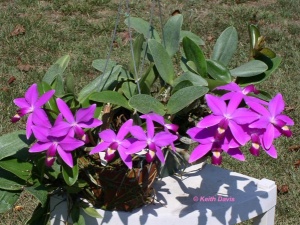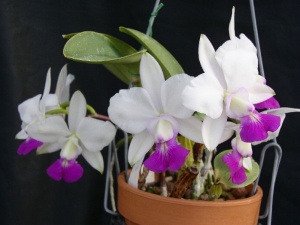Bifoliate Cattleya Species
C. aclandiae 'Verde' AM/AOS
C. aclandiae 'Black Wolf' and 'Blue Surprise'
C. aclandiae 'Black Wolf' and 'Blue Surprise' are, incredibly, siblings from the selfing of 'Gulfglade' AM/AOS. The awarded clone called 'Blue Sky' HCC/AOS is also a sibling. Others have come out looking more like the typical color form of aclandiae.
C. aclandiae alba 'JB'
A friend got this from a species collector in England. This rare color form lacks spots or any pigment other than the chlorophyll in the segments. The leaves also lack spots and are a clear, light green.
C. amethystoglossa 'Bold Statement'
C. amethystoglossa 'Hutch' AM/AOS
This clone came from a dear friend, Helen Congleton in California. Her plant received an 82 point AM/AOS with one inflorescence and 22 blooms. Three years later the same plant received an astounding score of 95 points for a CCM showing 7 inflorescences and 150 blooms. This is testament to what an incredible grower Helen was. At the time, there was no CCE/AOS award (90+ points).
C. amethystoglossa 'Polar Star'
This clone was purchased as an unbloomed seedling from Kawamoto Orchids. It was supposed to be from a sib cross of two coerulea clones. Not sure what color form this should be called, but I like it.
C. bicolor var. brasiliensis
C. bicolor 'Mendenhall-Beta'
C. dolosa 'Inferno Survivor'
.
C. granulosa 'Breckinridge Lime' 4N mutation
The clone of 'Breckinridge Lime' received an AM/AOS. Later it was mericloned and this 4N mutation was selected from the mericlones. Plant is more compact, blooms are a bit smaller but have proportionally wider segments with much heavier substance and the color is more intense and saturated.
C. guttata 'Brecko-Leopard' AM/CCE/AOS
This clone was obtained from Breckinridge Orchids who originally purchased it from Jones and Scully as a bareroot, freshly imported plant in the 1960's. The plant has grown well and the combined weight of the plant and pot is about 100 pounds. Top photo shows one method of establishing a new division. I call this my "no-stress division". Photo shows the CCE blooming and bottom photo how it was packed in a rented truck for transport to judging.
C. harrisoniana 'Frick and Frack' AM/AOS and 'Galactic Glow' AM/AOS
The 'Frick and Frack' and 'Galactic Glow' clones are from a selfing of the awarded C. loddigesii var. harrisoniana 'Streeter's Choice' FCC/AOS. There has been much debate as to the validity of this as a real species, but characteristics strongly favor it to be C. harrisoniana over loddigesii because of growth habit and blooming time. I have seen many selfings of 'Streeter's Choice', but none quite as good as the parent. Also, the selfings seem to have a better flower display in that they are not quite as tightly bunched together.
C. intermedia alba 'Breckinridge Snow' and 'Virgin Snow'
From Breckinridge Orchids, originally a collected plant that Mark Rose acquired back in the 1960's, a true intermedia alba unlike several awarded hybrids that are mislabeled as intermedia. Breeds white. Photo shows 2N 'Breckinridge Snow' on left and the 4N mutation 'Virgin Snow' on right, exactly like 'Breckinridge Snow' but significantly larger in every dimension.
C. intermedia coerulea 'Big Plant'
C. intermedia 'Show Off' with aquinii 'Sport'
This plant was obtained at the first Merritt Huntington Symposium as a small unbloomed seedling. After several years of blooming faithfully, one of the leads mutated and started to produce the aquinii blooms you can see in the photo. They have the distinct flare coloring on the petal tips. Also, the lip gained different markings more typical of the "orlata" variety.
C. intermedia var. orlata 'Rio'
The term "variety orlata" refers to when the lip's color pattern completely encircles the outside edge of the lip. Several species of cattleya have this color variety, not just in intermedia.
C. leopoldii alba 'Bracey'
C. leopoldii 'Dark Prince' HCC/AOS award blooming
This clone shows traits of a possible tetraploid (4N) mutation. Color is more saturated, flower segments have heavier substance and plant growth seems to be shorter than normal 2N form.
C. loddigesii 'April's Pride'
This was my daughter April's favorite that we bloomed from a seedling batch of 'Shorty' x 'Sweetheart'. It is very flat and blooms are large for the species. Somebody will get this awarded.


C. loddigesii 'Carina' AM/AOS and 'Tony 'Bos'
These two clones came from the famous Jones & Scully Orchids, Inc. The clone 'Carina' was awarded an AM/AOS of 89 points in 1987. The 'Tony Bos' clone has not been awarded that I am aware of. Mr. Robert M. Scully kindly shared some history of these two clones which I quote. "...both clones came from the private collection of Ademar Manarini, a very successful Brazilian from Sao Paulo who fancied the best of the best among native Brazilian orchid species, primarily in the cattleya group. His knowledge of orchids impressed my father, and later, all of us associated with his selections once commercialized via our company and his micro propagation lab, Equilab." Tony Bos who was the superintendent and minority owner at J&S struck up a pleasant relationship with Mr. Manarini who suggested naming one of his special C. loddigesii clones to recognize his new American friend, Tony Bos. Mr. Scully continues.."ironically, many of us have felt from the beginning that 'Tony Bos' produces a better flower than does 'Carina'. Just last spring (2013), a Japanese grower offered small divisions of 'Tony Bos' at the Redlands Orchid Festival for several hundred dollars, remarking at the same time that the clone was better than 'Carina'."
I am grateful to Mr. Scully for sharing these historical facts with us concerning these two famous and beautiful clones. There is a great photo of a smiling Tony Bos on page 3 of the 1987 J&S catalog which was dedicated to Mr. Robert M. Scully Sr. who had recently passed away.
C. loddigesii 'Dixie Land Blues' AM/AOS
Very rare 4N mutation from 'Blue Sky' selfing that was treated to increase ploidy. This plant was awarded with 85 points as a first bloom seedling. I think it has FCC potential. Vigorous grower unlike many 4N plants. This could be a valuable stud plant as well as a unique collector's treasure.
C. loddigesii 'Martineli'
C. loddigesii 'Sweetheart' AM/AOS
C. loddigesii var. harrisoniana 'Streeter's Choice' FCC/AOS
This plant is famous, not only for its FCC/AOS award, but for the controversy over its validity as a true species. It was shown by Dr. Robert Streeter in 1988 for its award and later given a plant patent. Mericlones were produced in very limited numbers and offered by H&R nursery in Hawaii for several hundred dollars. To me, it exhibits more of the characteristics of C. harrisoniana because of the color, growth habit and bloom season. Yet it does not fit completely into what is normally considered the traits of C. harrisoniana nor loddigesii. The fact that it does not fit neatly into either species may be a result of chromosome aberrations that we normally do not see or it could be a hybrid. Nonetheless, when well grown, it is one of the most beautiful bifoliate cattleyas you will ever see.
C. nobilior var. amaliae 'Fabio Nahas'
A fellow sent this to me to try and rescue it for him. He told me he paid $500 for a small 3 bulb division. After a couple of years, it had shriveled down to one leafless, rootless bulb not much larger than a pea. I placed it in a tiny pot about 1" in diameter on top of a bit of live Spanish moss. Miraculously, it came back and this photo was taken 8 years later. This species is most rewarding with the long lasting, fragrant blooms in late winter. For a bifoliate, it is amazingly compact. An excellent article on C. nobilior can be found in the November, 2004 issue of ORCHIDS magazine. There are several color forms that are fun to collect.
C. schilleriana 4N '44 Magnum'
C. schilleriana var. coerulea 'Blue Eagle' AM/AOS
C. violacea 'Icabaru' AM/AOS
C. violacea 'Iwata's Star'
C. violacea 'Jean Wilson' FCC/AOS
C. violacea 'Muse' FCC/AOS
C. walkeriana 'Sierra Storm' AM/AOS
C. walkeriana 'The Chairman'
C. walkeriana v coerulea 'Monte Azul' AM/AOS
Originally came from Mr. Luiz Carlos Peterson in Brazil to Ervin Granier from whom I purchased the plant. The plant was collected in the 1970'S in the State of Pernambuco in the region called Garanhunsl , Brazil.
C. walkeriana 'Welcome Back'

